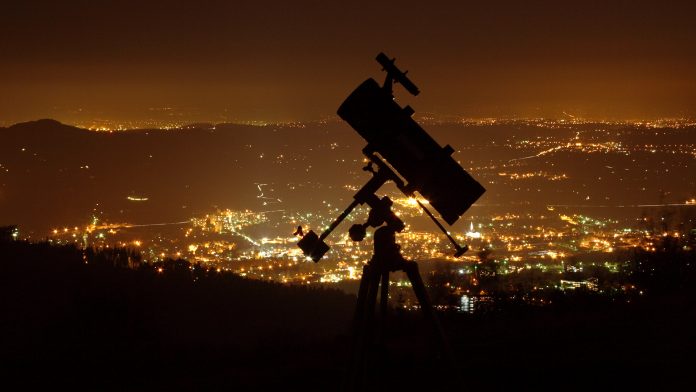A team of researchers has analysed more than 50,000 naked-eye observations of stars around the world as part of the Globe at Night Citizen Science Project. They discovered that due to light pollution, people around the world are seeing fewer stars in the night sky.
This change in visibility can be explained by an increase in light pollution by around 7-10% per year. This rate of change is faster than satellite measurements of artificial light emissions on Earth have first suggested.
The study was conducted by a group led by Christopher Kyba of the GFZ German Research Centre for Geosciences and the Ruhr-Universität Bochum, along with colleagues from the GFZ and the US National Science Foundation’s NOIRLab.
The corresponding paper, ‘Citizen scientists report global rapid reductions in the visibility of stars from 2011 to 2022,’ was published in the journal Science.
Why is light pollution dangerous?
Over the majority of the Earth’s land surface, the sky glows with an artificial twilight long after the Sun has set. This glow is a form of light pollution that can have serious effects on the environment and should have been the focus of research since its inception.
Many behaviours and psychological processes of living creatures are determined by daily and seasonal cycles and are therefore influenced by light. Constance Walker, head of the Globe at Night project and co-author of the study, emphasised: “Skyglow affects both diurnal and nocturnal animals and also destroys an important part of our cultural heritage.
“The appearance of the night sky is changing, with further negative effects on stargazing and astronomy.”
Using sustainable measurement methods to analyse the sky
Previously, the changes in light pollution over time have not been measured globally. While in principle, it could be measured by satellites, the only current sensors that monitor the entire Earth do not possess sufficient accuracy or dependency.
Therefore, scientists have turned to using the observational power of the people, using the human eye as a sensor. From this idea, the Globe at Night project was founded, with people around the world able to participate.
Participants simply look at their night sky and report which of a set of eight chart stars best matches what they see using an online form. Each chart shows the sky under different levels of light pollution.
“The contributions of individual people work together as if they were a global sensor network, making new science possible,” said Christopher Kyba. Together with the research team, Kyba has analysed data from 51,351 participants around the world, taken on cloud and moon-free nights between 2011 and 2022. Fluctuations were obtained from 19,262 locations worldwide, including 3,699 locations in Europe and 9,488 in North America.
To calculate a rate of change in light pollution from this data and consider that the observers were also at different locations over the years, the team made use of a global model for sky brightness based on satellite data from 2014.
Surprising findings
“The rate at which stars are becoming invisible to people in urban environments is dramatic,” said Kyba. The team found that the change in the number of visible stars can be explained by increases in the night sky’s brightness. In Europe, there was a 6.5% increase per year, while in North America light pollution increased by 10.4%.
To put these numbers into a more understandable context, Kyba explains the consequences of seeing stars in a place with a 9.6% per year increase, which was the average over all locations worldwide. “If the development were to continue at that rate, a child born in a place where 250 stars are visible will only be able to see 100 stars there on his 18th birthday.”
Based on the slower growth in upward emissions seen in satellite data, the researchers were surprised by the speed of this development in skyglow. In fact, for the locations of the observers, the artificial brightness measured by satellite had slightly decreased (by 0.3% per year in Europe and 0.8% in North America).
Why were different measurements of light pollution between Earth and space observed?
Kyba believes that the difference between human observation and satellite measurements is likely due to changes in lighting practices. He explained: “Satellites are most sensitive to light that is directed upwards towards the sky. But it is horizontally emitted light that accounts for most of the skyglow.
“So, if advertisements and facade lighting become more frequent, bigger, or brighter, they could have a big impact on skyglow without making much of a difference on satellite imagery.”
Another factor that could account for the different measurements of light pollution is the widespread switch from orange sodium vapour lamps to white LEDs, which emit much more blue light.
“Our eyes are more sensitive to blue light at night, and blue light is more likely to be scattered in the atmosphere, so contributes more to skyglow,” Kyba said. “But the only satellites that can image the whole Earth at night are not sensitive in the wavelength range of blue light.”
Limitations and further potential of the study
Despite the Globe at Night project being a major advancement in studying light pollution, the study also has its limitations. For example, the number of participants from different regions of the world determines the significance of spatial and temporal trends. So far, people from North America and Europe have had the largest participation in the experiment, while half of the contributions from Asian countries come only from Japan.
“The most data comes from the regions of Earth where skyglow is currently most prevalent. That’s useful, but it means that we can’t say much about skyglow change in regions with few observations,” Kyba stated. In developing countries in particular, rapid changes in artificial skyglow are suspected, however, there have been few observations so far.
The researchers have drawn two main conclusions from their findings. On one hand, they have shown that current lighting policies, such as the use of LEDs, have not yet brought about any improvement, at least on a continental level, despite the growing awareness of light pollution.
“And on the other hand, we were able to demonstrate that the Citizen Science data represent an important supplement to the previous measurement methods,” Kyba said.
Walker concluded: “If we had broader participation, we could identify trends for other continents, and possibly even for individual states and cities. The project is ongoing, so feel free to take a look tonight and let us know what you see!”









